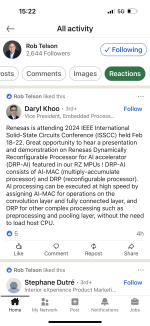Not initially happy, that we have to dance with the Devil again, but it's good to have a bigger cash buffer.
"As we enter 2024 with the momentum to grow the business on multiple vectors with our 2nd
generation Akida TM products, the Edge Box initiative and strategic partnerships, we need the ability to rapidly invest for growth and build on our lead” said Sean Hehir, CEO, BrainChip. “While we will continue to be judicious with our use of cash, having access to funding from our well-respected partners at LDA Capital, strengthens our business continuity position against well-capitalized and more established competitors in a highly competitive market.”
Sean's strategy, is for aggressive growth and penetration of the Edge A.I. market and we simply cannot do that, with the unpredictability of current incoming revenue.
With tapeout costs and production of AKD 2000 reference chips, likely to be around 7 million dollars or more (my guess) the Company, can't rely on piece meal incoming funds, to pursue it's strategy, of Edge A.I. domination and keep everything running as well.
It remains to be seen, if BrainChip can secure any AKIDA 2 IP deals, without a reference chip.
I believe, on the strength it's now multiple year relationships with other companies and their trust in the abilities of the BrainChip team (with its accomplishments in AKIDA technology thus far) that it's possible..
But I nor the Company, can hold its breath on that one..
Any additional income, will also be strongly applied to growth at this stage and if progress and an increasing share price can be met, the LDA arrangement will provide much more than the minimum 12 million dollars.
All the better, to aggressively grow the Company.
Shareholders need to understand, that while we are technologically Superior, we are competing against companies that absolutely dwarf us, with their financial and market muscle.
BrainChip is playing the
"We will be a future Big Market player" card and we need a bigger bank roll, to back that up.
Of course there is an element of risk in such an aggressive growth strategy, but Sean knows he has "very good cards" (as does everyone else at the table)..
Overall, I'm personally pleased at the financial security, this gives the Company going forward.
Remember, BrainChip plans on being around, for a long, long, long time and in a Big way.
View attachment 53262
Technologically superior.




